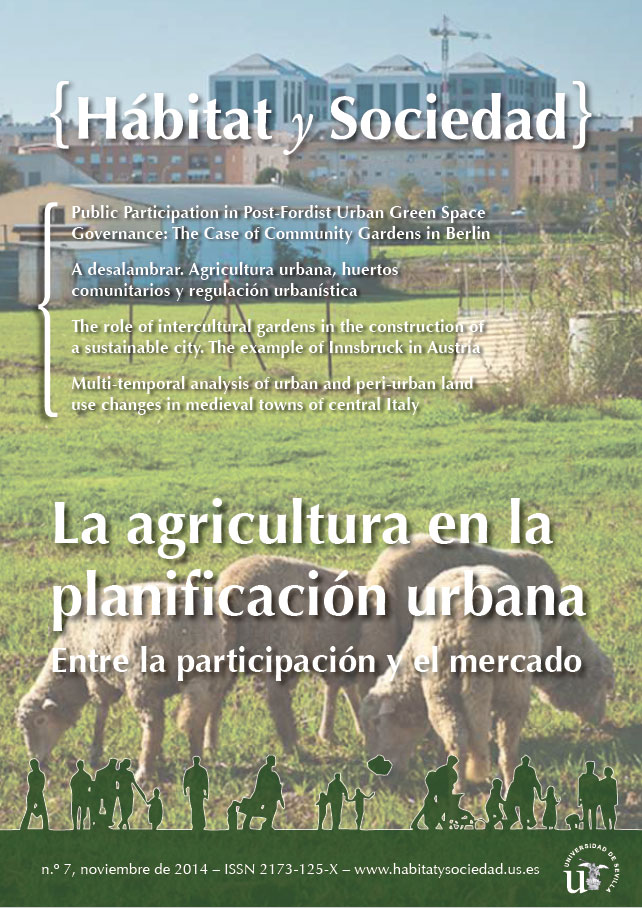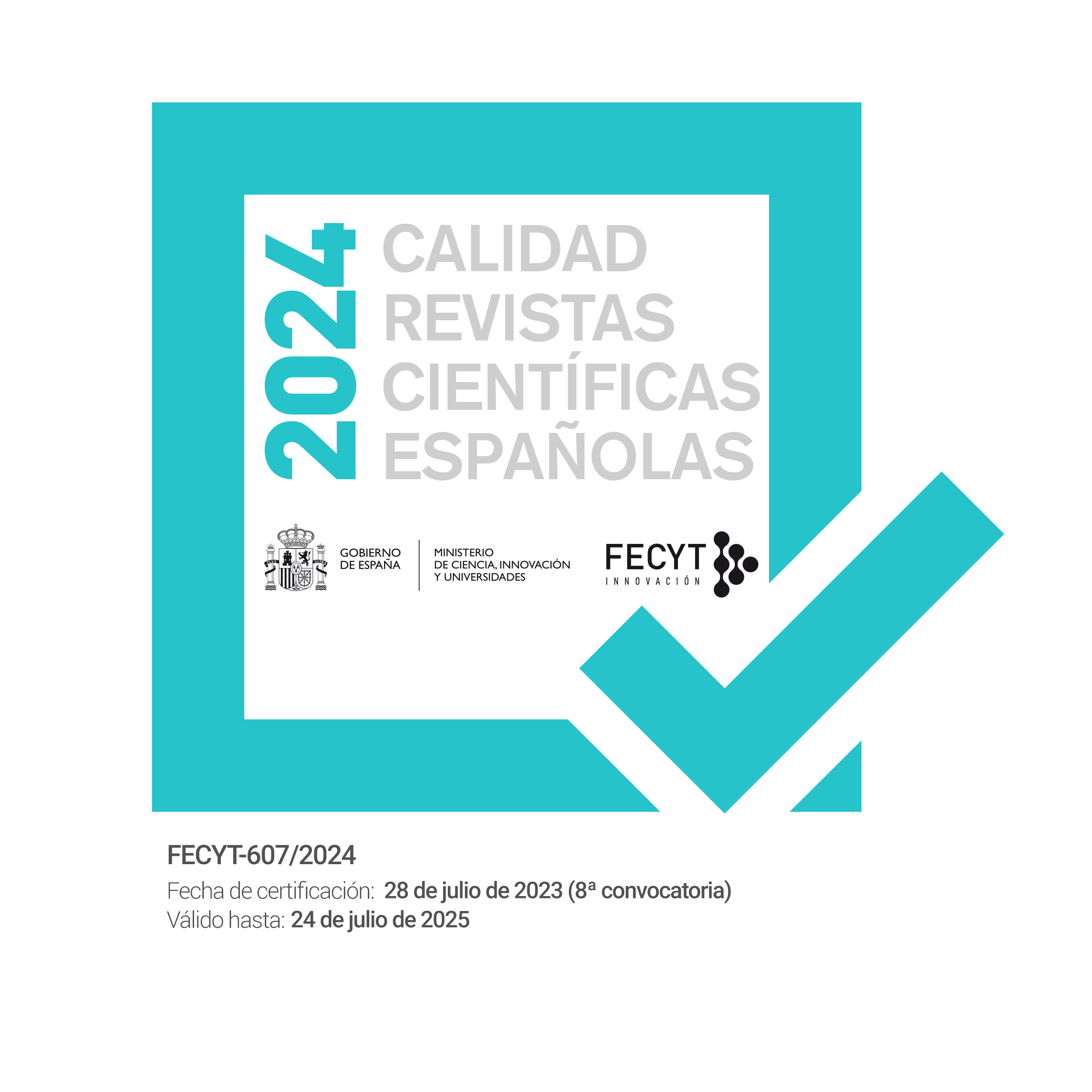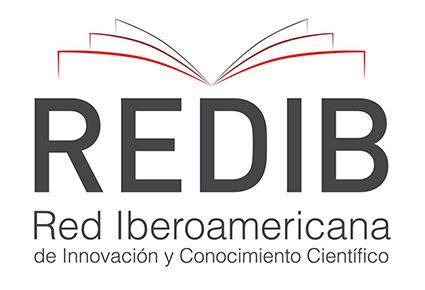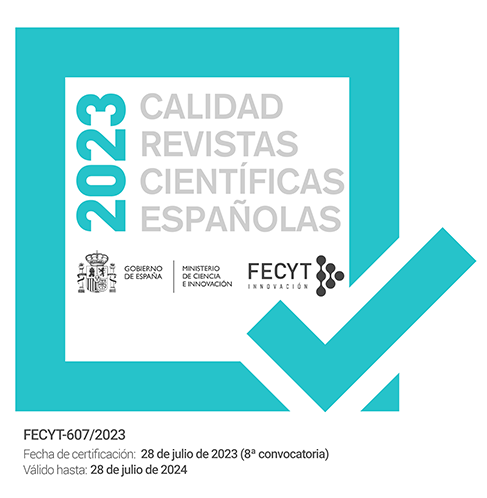Transnational at Home: Intercultural Gardens and the Social Sustainability of Cities in Innsbruck, Austria
DOI:
https://doi.org/10.12795/HabitatySociedad.2013.i7.04Keywords:
Jardines interculturales, espacio transnacional, transmigración, sostenibilidad social, capital socialAbstract
The impact of social stability and cohesion on the sustainability of cities gains importance as changing relations between societal groups of different cultural background increasingly shape life in urban environmentsdue to global migration. Urban gardening initiatives and intercultural gardens are receiving growing public attention, especially within Germany and Austria, as a means of migrant integration. The paper uses the intercultural community garden in the Austrian city of Innsbruck as a case to illustrate these processes. The empirical material is based on interviews, besides observations during a public garden visit and newspaper clippings. The paper describes changing patterns from classical
emigration over work migration to transmigration and living in transnational social spaces. Intercultural gardens are conceptualized as specific forms of transnational spaces, which localize them and at the same time open them to multi-ethnic spaces. As intercultural gardens
are organized as communal spaces, they provide new social networks for persons from different provenance and encourage various learning processes. Thus they impact on two key dimensions of the social sustainability of cities, social cohesion and the stability of communities,
and allow new ways of interaction between different cultures beyond assimilation and integration.
Downloads
References
Al-KATTIB, Jasmin. Interkultureller Garten Innsbruck -
Verständigung auf unüblichen Wegen (Der Standard
12.2011) <http://dastandard.at/1322872911495/
Interkultureller-Garten-Innsbruck-Verstaendigungauf-
unueblichen-Wegen> (Accessed on 1.3.2013).
AMELINA, Anna. Transnationale Migrantion jenseits
von Assimilation und Akkulturation Berliner Journal
für Soziologie, 2010, vol. 20, n.º 2, p. 357-279.
ARMSTRONG, Donna. A survey of community gardens
in upstate New York: Implications for health
promotion and community development. Health &
Place, 2000, vol. 6, p. 319-327.AUGUSTINA, Imas;
BEILIN, Ruth. Community Gardens: Space for Interactions
and Adaptations.Procedia - Social and Behavioral
Sciences 2012, vol. 36, p. 439-448.
BALASZTI, Erika; JASCHINSKI Ina; KYTIR, Josef;MARIK-LEBECK, Stephan; WIESBAUER Alexander; FASSMANN Heinz. Migration &Integration - zahlen.
daten.indikatoren 2012. Vienna: Statistik Austria
<http://www.bmi.gv.at/cms/BMI_Service/Integration_
/migration_integration_2012_72dpi.pdf>
(Accessed on 12.11.2013).
BARTOLOMEI, Linda; CORKERY, Linda; JUDD, Bruce; THOMPSON Susan. A Bountiful Harvest: Community Gardens and Neighbourhood Renewal in
Waterloo. New South Wales Government – Department of Housing; University of New South Wales, 2003. <http://www.housing.nsw.gov.
au/NR/rdonlyres/546938ED-F0E9-433F-9861-3093F11664E6/0/ABountifulHarvest.pdf> (Accessed on 12.11.2013).
BAUER Werner. Zuwanderung nach Österreich. Wien: Österreichische
Gesellschaft für Politikberatung und
Politikentwicklung-ÖGPP, 2008. <http://www.forschungsnetzwerk.
at/downloadpub/zuwanderung_
nach_oesterreich_studie2008_oegpp.pdf> (Accessed
on 12.11.2013).
BECKIE, Mary; BOGDAN, Eva. Planting roots: Urban
agriculture for senior immigrants Journal of Agriculture,
Food Systems, and Community Development, 2010,
vol. 1, n.º 2, p. 77–89.
BELASCO, Warren. Meals to Come. A History of the Future
of Food. Berkeley: University Press of California.
California Studies in Food and Culture, 2006.
BOURNE, Larry. Migration, immigration and social sustainability:
The recent Toronto experience in comparative
context. Toronto: Joint Centre of Excellence
for Research on Immigration and Settlement,
<http://ceris.metropolis.net/Virtual%20Library/
Demographics/bourne1.html> (Accessed on
11.2013).
BRAMLEY, Glen, POWER, Sinead. Urban form and social
sustainability: the role of density and housing
type. Environment and Planning B, 2009, vol. 36, p.
-48.
BUDE, Heinz. Die Ausgeschlossenen. Das Ende vom Traum
einer gerechten Gesellschaft, München: Hanser, 2008.
CHIU Rebekka. Social Sustainability, sustainable development
and housing development: The experience
of Hong Kong. In FORREST, Ray and LEE,
James (eds.) Housing and social change: East-west perspectives,
Routledge, 2003, p. 221-239.
COLEMAN, James. Social Capital in the Creation of
Human Capital. The American Journal of Sociology.
, vol. 94, p. 95-120.
CORRIGAN Michelle: Growing what you eat, developing
community gardens in Baltimore, Maryland.
Applied Geography, 2011, vol. 31, p. 1232-1241.
CUMMINS, Steven, MACINTYRE, Sally. “Food deserts”
–evidence and assumption in health policy making.
British Medical Journal, 2002, vol. 325, p. 436-438.
DEMPSEY, Nicola; BRAMLEY, Glen; POWER, Sinead;
BROWN, Caroline. The Social Dimension of Sustainable
Development: Defining Urban Social Sustainability.
Sustainable Development, 2011, vol. 19, p.
-300.
FAIST, Thomas. The Transnational Social Spaces of Migration.
Bielefeld: COMCAD, (Working Papers-Center
on Migration, Citizenship and Development; 10), 2006.
FAIST, Thomas. Diaspora and transnationalism: What
kind of dance partners? In BAUBÖCK, Rainer and
FAIST, Thomas (eds.) Diaspora and Transnationalism
Concepts, Theories and Methods Amsterdam University
Press, 2010, p. 9-34,
FLAVELL, N. Urban Allotment Gardens in the
Eighteenth Century: The Case of Sheffield. The
Agricultural History Review, 2003 vol. 51, n.º 1, p. 95-
FLORA, Jan et al. New Immigrants in Local Food Systems:
Two Iowa Cases International Journal of Sociology
of Agriculture and Food, 2012, vol. 19, n.º 1, p. 119-
FRANCIS, Mark: A Research Agenda for the Impact
of Community Greening, Revisited. Community Greening
Review, 2009, vol. 13, p. 61-63
communitygarden.org/docs/cgr2009.pdf> (Accessed
on 10.11.2013).
FUREY, Sinaed; STRUGNELL, Christopher; MCLLVEEN,
Heather. An investigation of the potential
existence of “food deserts’’ in rural and urban areas
of Northern Ireland. Agriculture and Human Values,
, vol. 18, n.º 4, p. 447-457.
GLICK - SCHILLER, Nina; BASCH, Linda; BLANCSZANTON
Christina. From Immigrant to Transmigrant: Theorizing Transnational Migration. Anthropological
Quarterly, 1995, vol. 68, n.º 1, p. 48-63.
KELLY, Monica. Cultivating Respect for Difference: exploring
the enactment of community at HOPE garden in
Parkdale, Toronto. Masters Thesis University of Western
Ontario, London, Canada, 2012.
LONDON SUSTAINABLE DEVELOPMENT COMMISSION.
A Great London: Making It Happen. 2007.
<http://www.londonsdc.org/documents/research/
Making_it_happen_scn_12Oct07.pdf>. (Accessed
on 11.11.2013).
MANZI, Tony; LUCAS, Karen; JONES, Tony Lloyd;
ALLEN Judith. Social sustainability in urban areas:
communities connectivity and the urban fabric. Eathscan,
MAUSS, Marcel. Die Gabe: Form und Funktion des Austauschs
in archaischen Gesellschaften. Frankfurt/Main:
Surkamp Verlag, 1990 [1924].
METCALF, Sarah; WIDENER, Michael. Growing
Buffalo’s capacity for local food: A systems framework
for sustainable agriculture. Applied Geography,
, vol. 31, p. 1242-1251.
MOULIN-DOOS, Claire. Intercultural gardens: the
use of space by migrants and the practice of respect.
Journal of Urban Affairs, published online: 16
May 2013 DOI: 10.1111/juaf.12027.
MÜLLER, Christa. Wurzeln schlagen in der Fremde. Internationale
Gärten und ihre Bedeutung für Integrationsprozesse,
München: Oekom Verlag, 2002.
MÜLLER, Christa. Intercultural Gardens Urban Places
for Subsistence Production and Diversity German
Journal of Urban Studies, 2007, vol. 46, n.º 1,
www.difu.de/node/5963> (Accessed on 1.3.2013)
MÜLLER, Christa. Zur Bedeutung von interkulturellen
Gärten für eine nachhaltige Stadtentwicklung.
In GSTACH, Doris; HUBENTHAL, Heidrun; SPITHOVER, Maria (eds). Gärten als Alltagskultur im internationalen Vergleich. Arbeitsberichte des Fachbereiches Architektur, Stadtplanung, Landschaftsplanung. Universität Kassel, 2009, vol. 169, p. 119-134.
MÜLLER, Christa. Urban gardening – über die Rückkehr
der Gärten in die Stadt. München: Ökom Verlag,
MURPHY, Kevin The social pillar of sustainable development:
a literature review and framework for policy
analysis, Sustainability: Science, Practice & Policy,
vol. 8, n.º 1 p. 15-29. <http://sspp.proquest.
com/static_content/vol8iss1/1008-041.murphy.
pdf> (Accessed on 12.11.2013).
PIERSON John. Tackling Social Exclusion. London:
Routledge, 2002.
PORTES, Alejandro. Social capital: its origins and
applications in modern sociology. Annual Review of
Sociology, 1998, vol. 24, p. 1-24.
PORTES, Alejandro; SENSENBRENNER, Jiulia. Embeddedness
and Immigration: Notes on the Social
Determinants of Economic Action American Journal
of Sociology, 1993, vol. 98, n.º 6, p. 1320-1350.
PRIES, Ludger. Internationale Migration. Transcript Verlag.
PRIES, Ludger. Transnationalismus, Migration und
Inkorporation. Herausforderungen an Raum- und
Sozialwissenschaften. Geographische Revue Zeitschrift
für Literatur und Diskussion, 2003, vol. 5, n.º 2, p.
-38.
SIEBEL, Walter. Die Zukunft der Städte. Aus Politik
und Zeitgeschichte, 2010, vol. 17, p. 3-9.
RATCLIFFE, Peter. Is the assertion of minority identity
compatible with the idea of a socially inclusive
society? In ASKONAS, Peter; STEWARD, Angus
(eds). Social Inclusion: Possibilities and Tensions. Basingstoke:
Macmillan, 2000, p. 169-185.
RENTING, Henk; SCHERMER, Msrkus; ROSSI, Adanella.
Building Food Democracy: Exploring Civic
Food Networks and Newly Emerging Forms of
Food Citizenship. International Journal of Sociology of
Agriculture and Food, 2012, vol. 19, n.º 3, p. 289-307.
ROSENFELD Martin: Mobility and social capital
among Lebanese and Beninese entrepreneurs engaged
in transnational trade. International Review of
Sociology, 2012, vol. 22, n.º 2, p. 211-228.
ROSOL Marit, Gemeinschaftsgärten in Berlin – eine qualitative
Untersuchung zu Potenzialen und Risiken bürgerschaftlichen
Engagements im Grünflächenbereich vor
dem Hintergrund des Wandels von Staat und Planung,
PhD Thesis Humbold Universität, Berlin, 2006.
<http://edoc.hu-berlin.de/dissertationen/rosolmarit-
-02-14/PDF/rosol.pdf> (Accessed on
11.2013).
ROSOL, Marit, Public Participation in Post-Fordist Urban
Green Space Governance: The Case of Community
Gardens in Berlin. International Journal of
Urban and Regional Research, 2010, vol 34, n.º 3, p.
-563.
RUSH, Lara. Rethinking bridging: risk and trust in
multiracial community organizing. Urban Affairs
Review, 2010, vol. 45, n.º 4, p. 483-506.
SETO, Darlene. Diversity and engagement in alternative
food practice: community gardens in Vancouver MA.
Thesis University of Calgary, 2009.
ubc.ca/bitstream/handle/2429/39820/ubc_2012_
spring_seto_darlene.pdf?sequence=3> (Accessed
on 12.11.2013).
TABORSKY, Ursula: Naturzugang als Teil des Guten Lebens: Die Bedeutung interkultureller Gärten in der Gegenwart. Frankfurt am Main; Wien: Verlag Peter Lang, 2008.
TAFT, Ronald. The Shared Frame of Reference Concept
Applied to the Assimilation of Immigrants.
Human Relations, 1953, vol. 6, p. 45-55.
TURKINGTON, Richard; SANGSTER, Kim. From
housing mix to social mix-Housing’s contribution
to social sustainability. Town and Country Planning,
, p. 184-185.
WOIDICH Andreas Tu felix Austria? Migration von
Deutschland nach Österreich im Trend – Eine Studieüber deutsche Erwerbstätige in den Bundesländern Tirol,
Salzburg und Oberösterreich. Diploma Thesis Ludwig-
Maximilians-Universität München, 2009.
www.forschungsnetzwerk.at/downloadpub/Migration_
von_Deutschland_nach_Oesterreich_im_
Trend.pdf> (Accessed on 12.11.2013).
WALTER, Pierre. Theorising community gardens as
pedagogical sites in the food movement. Environmental
Education Research, 2013, vol. 19, n.º 3, p. 521-
WOOLCOCK, Michael. Social Capital and Economic
Development: Towards a Theoretical Synthesis and
Policy. Theory and Society, 1998, vol. 27, p. 151-124.
Downloads
Published
How to Cite
Issue
Section
License
Copyright (c) 2017 De los autores y Editorial Universidad de Sevilla

This work is licensed under a Creative Commons Attribution-NonCommercial-ShareAlike 4.0 International License.
Los textos publicados se considerarán propiedad intelectual de los autores y de la revista. Podrán ser usados para usos educativos y académicos, citando al autor y la publicación, con la dirección electrónica exacta. En todo caso, deberá comunicarse este tipo de uso y pedir la autorización del mismo a la dirección de la revista.
Los autores/as que publiquen en esta revista aceptan las siguientes condiciones:
- Los autores/as conservan los derechos de autor y ceden a la revista el derecho de la primera publicación, con el trabajo registrado con la licencia de atribución de Creative Commons, que permite a terceros utilizar lo publicado siempre que mencionen la autoría del trabajo y la primera publicación en esta revista.
- Los autores/as pueden realizar otros acuerdos contractuales independientes y adicionales para la distribución no exclusiva de la versión del artículo publicado en esta revista (p. ej., incluirlo en un repositorio institucional o publicarlo en un libro) siempre que indiquen claramente que el trabajo se publicó por primera vez en esta revista.
- Se permite y recomienda a los autores/as publicar su trabajo en Internet (por ejemplo en páginas institucionales o personales) antes y durante el proceso de revisión y publicación, ya que puede conducir a intercambios productivos y a una mayor y más rápida difusión del trabajo publicado (véase The Effect of Open Access).














